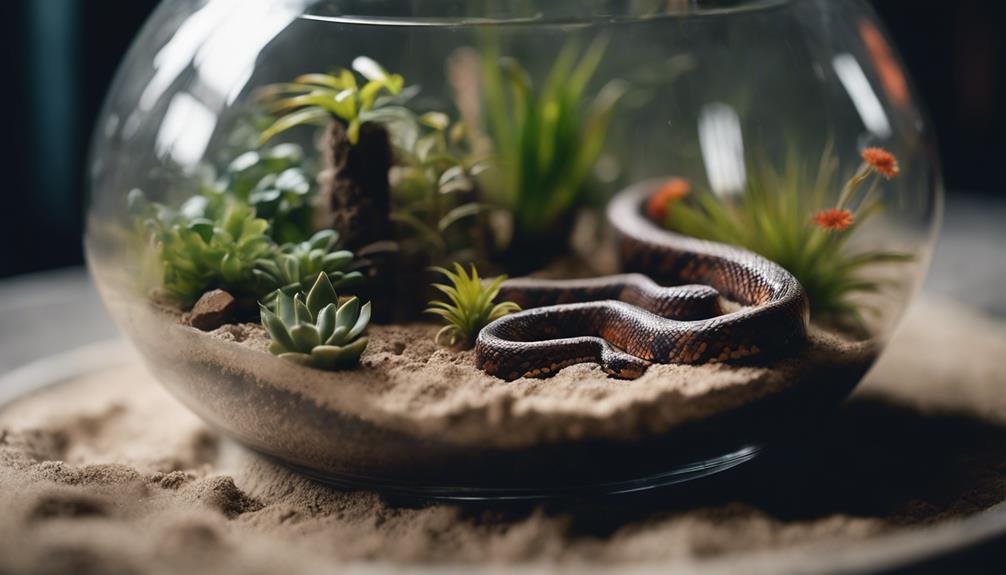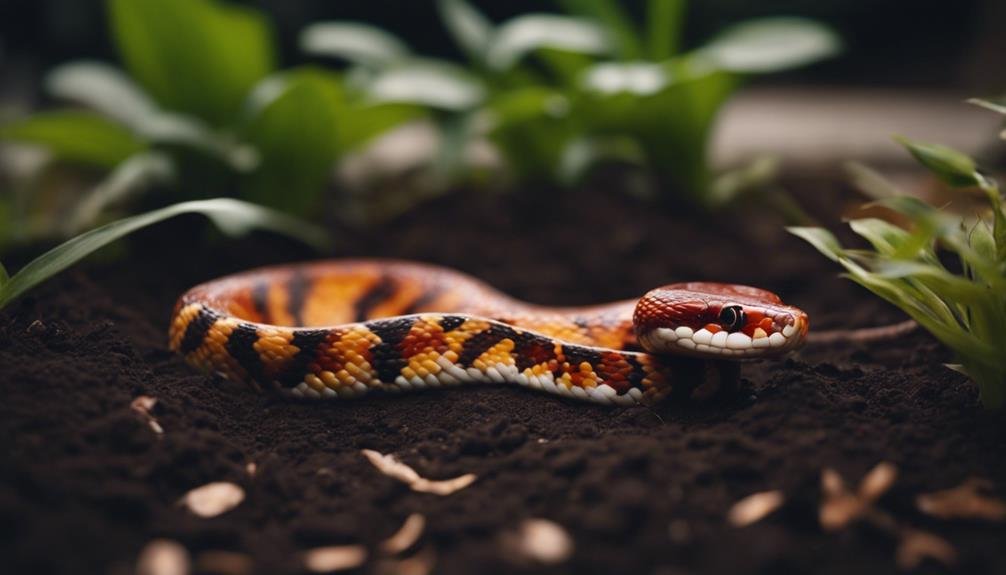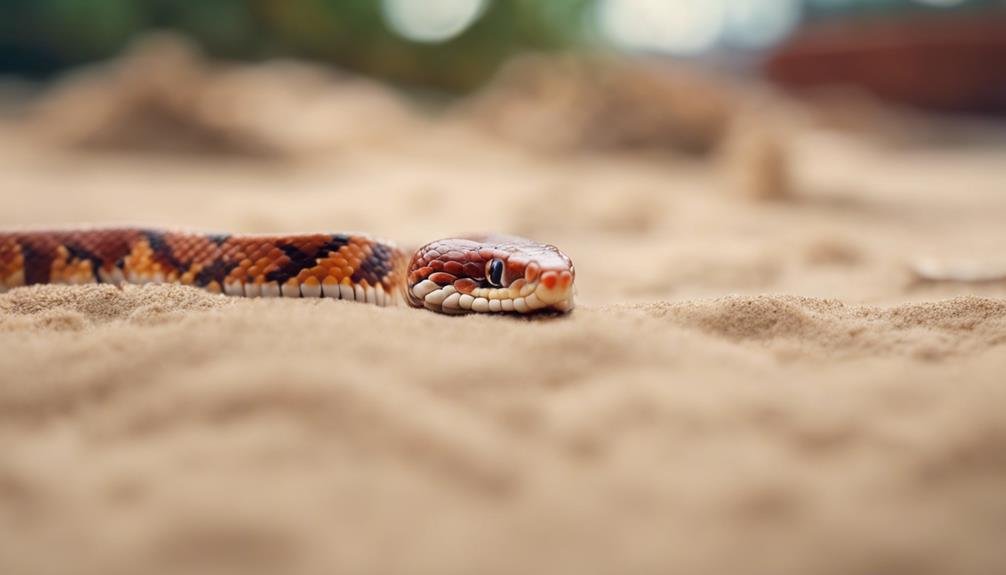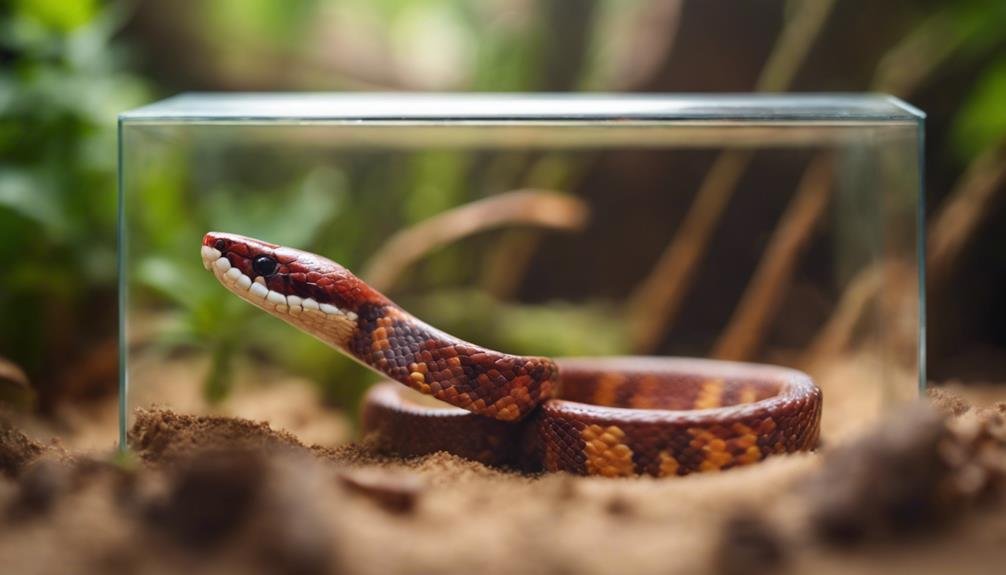If you’re considering sand as a substrate for your corn snake’s enclosure, you might want to think again. While the aesthetic appeal of sand can’t be denied, it falls short in providing a safe and comfortable environment for these reptiles. Sand’s inability to retain moisture leads to low humidity levels, which are important for your snake’s shedding process. Additionally, the risk of impaction from accidental ingestion of sand cannot be overlooked. But what makes other substrates a better choice for your corn snake’s health and well-being? Join the conversation to uncover the alternatives that cater to the natural needs of your pet.
Key Takeaways
- Corn snakes do not prefer sand as it can cause irritation to their eyes and tongue.
- Sand’s non-absorbent nature leads to poor humidity control, affecting shedding and health.
- Ingesting sand risks impaction, causing digestive blockages and health issues in corn snakes.
- Sand lacks the necessary traction for corn snakes to move and shed their skin effectively.
- Safer substrate alternatives like aspen bedding and coconut fiber better support corn snakes’ natural behaviors and health.
Understanding Corn Snake Preferences
To guarantee your corn snake’s happiness and health, understanding their specific substrate preferences is crucial. Recognizing that corn snakes have a natural aversion to sand due to its non-absorbent nature is paramount. This type of substrate can foster bacterial growth and hygiene issues, not to mention it’s harsh on their skin and eyes. Instead, focus on substrate options that echo their natural habitat, providing both comfort and utility.
Substrates like aspen bedding or paper towels aren’t only important but also support your corn snake’s needs more effectively. They offer the necessary traction for movement and facilitate the shedding process. More importantly, these substrates aid in burrowing behavior, allowing your corn snake to exhibit natural instincts securely. Additionally, maintaining proper humidity levels is crucial for your corn snake’s well-being. Unlike sand, aspen bedding and paper towels help in retaining moisture, ensuring the habitat is conducive to your pet’s health. By choosing the right substrate, you’re not just enhancing your corn snake’s living environment; you’re actively contributing to its overall health and longevity.
The Risks of Sand Substrates
While some might consider sand an aesthetic choice for a corn snake’s habitat, it’s important to understand the risks this substrate poses to your pet’s health. Sand substrates, though seemingly natural, can stick to your snake’s tongue and eyes, causing irritation and discomfort that’s far from the wild experience you might aim to replicate. More than just an irritant, sand can lead to impaction in snakes. This serious condition hinders digestion, potentially causing severe health issues that could have been avoided with safer substrate options available.
Moreover, sand doesn’t provide the traction snakes need for effective movement and shedding. Imagine the struggle your snake must endure, trying to slither or shed its skin without adequate grip. This not only stresses them but can lead to health problems related to ineffective shedding.
In addition, sand’s non-absorbent nature promotes bacterial growth, creating an unhygienic environment for your corn snake. This increases the risk of respiratory problems and skin irritation, making it clear that the aesthetic appeal of sand is vastly outweighed by the potential harm it poses. With numerous safer substrate options available, prioritizing your snake’s health and well-being is essential.
Ideal Substrates for Corn Snakes


Now that you know sand isn’t the best choice for your corn snake, let’s explore the ideal substrates that guarantee their well-being.
Safe substrate options like aspen bedding or reptile carpet not only support your snake’s natural behaviors but also maintain proper moisture levels critical for their health.
These choices provide a comfortable and healthy environment, making it easier for you to maintain and for your corn snake to thrive.
Safe Substrate Options
Corn snakes’ well-being greatly benefits from choosing the right substrate. Options like coconut fiber and Zilla Jungle Mix stand out as ideal due to their safety and comfort. When exploring substrate options for your Corn Snake, you’ll find that sand isn’t a friend to their delicate skin or eyes. Instead, consider safe alternatives like the Bio Dude Terra Firma kit, hemp bedding, or Lugarti Natural Reptile Bedding. These substrates strike the right balance, supporting your snake’s natural behaviors like burrowing, without the risks sand poses.
They’re absorbent, low in dust, easy to clean, and reusable to an extent, making them cost-effective. By selecting the right substrate, you’re not just enhancing the enclosure’s look; you’re ensuring your Corn Snake thrives.
Substrate Moisture Levels
Understanding the right moisture level in your corn snake’s substrate is key to ensuring their habitat is both comfortable and healthy. Maintaining ideal substrate moisture levels is important for your corn snake’s well-being.
Sand can lead to excessive dryness or, conversely, retain too much moisture, negatively impacting your snake. Instead, opt for aspen bedding, coconut fiber, or paper towels. These options help regulate humidity effectively, creating a balanced environment.
Proper substrate moisture levels are necessary to prevent skin issues, respiratory problems, and dehydration. It’s important to choose substrates that balance moisture retention and drainage, ensuring a suitable habitat.
The Problem With Ingesting Sand
You mightn’t know that using sand as a substrate can seriously endanger your corn snake’s health.
If they ingest sand, they’re at risk of impaction, which blocks their digestive system, and can also suffer from reduced nutritional absorption.
These health concerns highlight why it’s important to reconsider sand as a suitable environment for your pet.
Sand Impaction Risks
Ingesting sand poses a serious risk for impaction in corn snakes, leading to digestive blockages that can be fatal. When you use sand as a substrate, you’re increasing the chance of your snake accidentally swallowing it during feeding or exploration. This can cause sand particles to accumulate in their intestines, which is especially dangerous for smaller snakes. They struggle more to pass these particles, heightening the risk of severe health issues or death. To safeguard your pet, opt for safer substrates like aspen bedding or paper towels, which greatly reduce the risk of impaction.
| Risk Factor | Impact on Corn Snakes | Prevention Strategy |
|---|---|---|
| Ingested Sand | Digestive Blockages | Use safer substrates |
| Small Size of Snake | Higher Impaction Risk | Monitor feeding closely |
| Natural Behaviors | Ingestion Risk | Provide naturalistic but safe environment |
| Substrate Choice | Directly affects safety | Choose aspen or paper |
| Health Consequences | Severe to fatal | Regular health checks |
Digestive Health Concerns
Many corn snakes face significant digestive health issues due to the ingestion of sand, a substrate that can cause impaction and blockages. When you choose sand as a substrate for your corn snake’s habitat, you’re inadvertently exposing them to a trio of digestive hazards:
- Sand particles accumulate in the digestive system, hindering proper digestion and leading to discomfort.
- Inability to pass ingested sand effectively, posing a serious health risk that can escalate to life-threatening complications.
- Discomfort and pain, as the accumulated sand causes impaction, preventing your snake from digesting its food properly.
To maintain your corn snake’s digestive health and overall well-being, it’s essential to avoid using sand as a substrate. This choice can prevent the painful and potentially fatal consequences of sand ingestion.
Nutritional Absorption Issues
Swallowing sand severely disrupts a corn snake’s ability to absorb essential nutrients from its food. When you choose sand as a substrate, you’re unknowingly risking your snake’s health. This seemingly vital substance can lead to impaction, blocking their digestive system and preventing the efficient breakdown and assimilation of nutrients.
Corn snakes can’t process sand effectively, which means it doesn’t just pass through their system harmlessly. Instead, it accumulates, causing discomfort, pain, and even serious health issues like intestinal obstructions. These blockages can trigger a cascade of problems, not just in their digestive tract but potentially affecting their respiratory health as well.
It’s important to understand that while sand might look natural or appealing, it poses significant risks to your corn snake’s well-being.
How Sand Affects Shedding
While sand may seem like a natural choice for a corn snake’s habitat, it’s not ideal for shedding, as it can stick to their skin and cause discomfort. The tiny sand particles can easily become lodged between their scales, leading to irritation that’s not just annoying but can be downright harmful for your slithery friend during this vulnerable time. Imagine the struggle as they try to rid themselves of their old skin, only to find sand complicating the process.
Here are three key issues with sand during shedding:
- Irritation and Discomfort: Sand particles rubbing against the skin can create significant irritation, making the shedding process uncomfortable and stressful.
- Impaction Risks: Ingesting sand, even accidentally, can lead to impaction and serious digestive issues. It’s a risk that’s easily avoided with the right substrate.
- Lack of Traction: Sand doesn’t offer the necessary grip for snakes to effectively shed their skin. They need something they can rub against to help peel away the old layer, and sand simply doesn’t provide that.
It’s clear that sand, while seemingly a natural bedding choice, poses too many risks during shedding.
Alternatives to Sand


Considering the risks associated with sand, let’s explore safer substrate alternatives for your corn snake’s habitat. Alternative substrates like aspen bedding, paper towels, reptile carpet, and contact paper offer not only a safer environment but also cater to the natural behaviors of corn snakes, such as burrowing. These options guarantee your snake can engage in its instinctual activities without the risk of irritation to its eyes and tongue, which sand can cause.
It’s important to take into account the natural habitat and behaviors of corn snakes when selecting a substrate. This attention to detail will enhance their well-being, providing a habitat that closely mimics their natural environment. Safety and comfort should always be your priority to prevent potential health issues and discomfort. While playground-grade sand and gravel can aid in drainage when used under the primary substrate, they should never be the main material in your snake’s enclosure.
Why Do Corn Snakes Often Avoid Sand as a Substrate?
Corn snakes often avoid sand as a substrate because it can cause impaction if ingested. The best substrate for corn snakes is something like aspen shavings or paper towels, which are safer for them to burrow and move around in without the risk of digestive issues.
Humidity Control and Substrates
Proper humidity levels are essential for your corn snake’s health, especially during the shedding process, which substrates like sand fail to support effectively. Sand, while seemingly a natural choice, falls short in maintaining the necessary moisture environment for your slithery friend. Humidity control isn’t just about keeping the air moist; it’s about creating a habitat that mimics their natural surroundings as closely as possible.
Choosing the right substrate is important for several reasons:
- Shedding Assistance: Inadequate humidity can lead to problematic shedding, where the old skin doesn’t come off in one piece. This can cause stress or even health issues for your pet.
- Respiratory Health: Humidity plays a key role in respiratory health. Sand’s inability to retain moisture can lead to dry air, which may contribute to respiratory problems in corn snakes.
- Natural Behavior: Corn snakes instinctively burrow and explore. They require a substrate that offers not just the right humidity but also traction and the ability to support these natural behaviors.
Substrates that can hold moisture effectively while allowing for easy burrowing and movement are preferable. It’s not just about picking a substrate; it’s about understanding the role of humidity control in your corn snake’s overall well-being.
Common Mistakes in Choosing Substrates


Many pet owners inadvertently harm their corn snakes by choosing sand, a substrate that poses several health risks. It’s important to understand that not all substrates are created equal, and some can greatly impact your snake’s well-being. Here’s a brief overview of common mistakes and better alternatives:
| Mistake: Using Sand | Better Alternative |
|---|---|
| Sticks to tongues and eyes, causing irritation | Use aspen bedding for comfort |
| Non-absorbent, promotes bacterial growth | Choose absorbent materials to keep the enclosure clean |
| Can cause internal injuries from ingestion | Select larger, non-ingestible substrates |
| Leads to skin abrasions | Opt for softer, snake-friendly options |
| Generally disliked by reptiles like corn snakes | Research species-specific substrate preferences |
Conclusion
So, you’ve learned that corn snakes aren’t fans of sand for good reasons. It’s rough on their bodies, poses health risks, and just doesn’t support their natural needs.
You’re better off choosing substrates like aspen bedding, reptile carpet, or coconut fiber, which cater to their well-being, allow for proper humidity, and prevent potential health issues.
Avoid common mistakes by steering clear of sand, ensuring your slithery friend enjoys a comfortable, healthy habitat. Remember, their safety and happiness come first.


